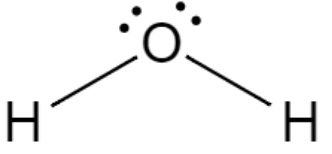
Is water ionic or covalent?
Answer
535.5k+ views
Hint: There are different types of bonds present between the atoms or the molecules which results in formation of different kinds of compounds accordingly.
Some of the bonds which could be differentiated from each other on the basis of the abilities of the atom and the flow of electrons are, ionic bond, covalent bond, hydrogen bond etc.
Complete answer:
An ionic bond is formed when one of the two atoms involved in the bond formation, donates its electrons in order to gain stability, and the other one accepts it for the same reason. The atom which donates electrons are called cations and the atoms which accept them are called anion, after the process of donation. This results in development of positive and negative charge on both the atoms, which leads to formation of attractive forces between them and hence a bond is formed. The atoms which are involved in this kind of bond formation would therefore have different electronegativity from each other. An example of ionic bond is sodium chloride or common salt, where the sodium atom donates the electrons and the chlorine atoms receive it.
On the other hand, a covalent bond is formed as a result of sharing of electrons between two atoms and in a true covalent bond, the electronegativity of both the atoms which are involved in the bond formation, would have equal values and so both the electrons would be in the middle of the bond. In general, there is some electronegativity difference in the atoms involved, and so the electrons would be slightly pulled by that atom having higher electronegativity, which would occasionally result in a polar nature in the bond.

Given above is the diagram of water where we can see one covalent bond is formed between oxygen and each hydrogen.
In the given question, it is asked if water is a covalent or ionic molecule. The correct answer would be, covalent molecule, as it shares electrons between the oxygen and hydrogen atoms.
Note: An ionic bond results from donation of electrons from one atom and acceptance of same electrons from another.
Whereas a covalent bond results from sharing of the electrons among both the atoms.
However, there may be electronegativity difference between the atoms in covalent bonds and so, it could result in a slight polar nature of the bond.
Some of the bonds which could be differentiated from each other on the basis of the abilities of the atom and the flow of electrons are, ionic bond, covalent bond, hydrogen bond etc.
Complete answer:
An ionic bond is formed when one of the two atoms involved in the bond formation, donates its electrons in order to gain stability, and the other one accepts it for the same reason. The atom which donates electrons are called cations and the atoms which accept them are called anion, after the process of donation. This results in development of positive and negative charge on both the atoms, which leads to formation of attractive forces between them and hence a bond is formed. The atoms which are involved in this kind of bond formation would therefore have different electronegativity from each other. An example of ionic bond is sodium chloride or common salt, where the sodium atom donates the electrons and the chlorine atoms receive it.
On the other hand, a covalent bond is formed as a result of sharing of electrons between two atoms and in a true covalent bond, the electronegativity of both the atoms which are involved in the bond formation, would have equal values and so both the electrons would be in the middle of the bond. In general, there is some electronegativity difference in the atoms involved, and so the electrons would be slightly pulled by that atom having higher electronegativity, which would occasionally result in a polar nature in the bond.

Given above is the diagram of water where we can see one covalent bond is formed between oxygen and each hydrogen.
In the given question, it is asked if water is a covalent or ionic molecule. The correct answer would be, covalent molecule, as it shares electrons between the oxygen and hydrogen atoms.
Note: An ionic bond results from donation of electrons from one atom and acceptance of same electrons from another.
Whereas a covalent bond results from sharing of the electrons among both the atoms.
However, there may be electronegativity difference between the atoms in covalent bonds and so, it could result in a slight polar nature of the bond.
Recently Updated Pages
Explain the internal structure of the kidney class 11 biology CBSE

Explain the preparation of acetic acid by a quick vinegar class 11 chemistry CBSE

The number of ways in which four letters of the word class 11 maths CBSE

Arrange Water ethanol and phenol in increasing order class 11 chemistry CBSE

Explain why pure liquids and solids can be ignored class 11 chemistry CBSE

Six particles situated at the corners of a regular class 11 physics CBSE

Trending doubts
10 examples of friction in our daily life

One Metric ton is equal to kg A 10000 B 1000 C 100 class 11 physics CBSE

Difference Between Prokaryotic Cells and Eukaryotic Cells

1 Quintal is equal to a 110 kg b 10 kg c 100kg d 1000 class 11 physics CBSE

State the laws of reflection of light

Explain zero factorial class 11 maths CBSE




